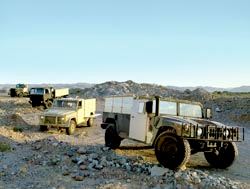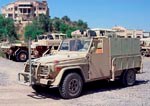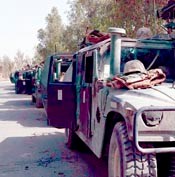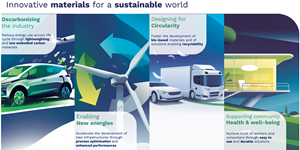Composites on the frontlines
Armored vehicle applications on the ground and in the air fuel a growing, evolving market forhigh-performance materials.
The terrorist attacks of Sept. 11, 2001 in New York City and Washington, D.C. continue to resonate throughout the world in many ways. One is the burgeoning demand for protective systems, from body and vehicle armor to cargo containers to blast-hardened buildings, to meet security needs at home and abroad. That demand has spurred production increases for high-strength ballistic fibers, including aramid, high-modulus polyethylene, high-strength glass and other advanced fibers.
According to investment firm Morgan Keegan & Co. Inc., the physical security products market will grow at a rate of 14 percent per year for the next eight years, and reach $29 billion (USD) in 2010. HPC covered the various materials used in a wide array of personal body armor previously (HPC March 2003, p. 23). The following is a survey of well-established products and several new developments in armor for ground vehicles and aircraft. In light of the increased awareness of the need for vehicle protection, as evidenced by the recent interaction between U.S. soldiers and U.S. Secretary of Defense Donald Rumsfeld, a number of armor system manufacturers and integrators are capitalizing on the demand.
Some background on armor and its components
A recent article published in the August issue of National Defense magazine points out the tradeoffs in protecting military trucks for battle. Battlefield commanders want light, maneuverable and fast vehicles, but also want vehicle occupants to be fully protected. Ballistic steel armor plates, while relatively inexpensive, add thousands of pounds to a light truck, which was not designed to carry the loads. The results have been numerous engine and transmission failures as well as problems with vehicle suspensions and brakes, most recently in Iraq. The additional weight reduces fuel efficiency and makes it impossible to carry additional personnel in the vehicle in case of emergency. For these reasons, military designers are beginning to adopt more lightweight composite armor across the board for light, medium and heavy trucks.
For composite armor, no single fiber type works best in all applications. Each has its own specific characteristics and properties, which can be exploited for different types of armor designs. Para-aramid fiber, such as Kevlar from Dupont Advanced Fiber Systems (Richmond, Va.) or Twaron from Teijin Twaron BV (Arnhem, The Netherlands), is perhaps the best-known high-performance ballistic fiber. A para-aramid variant is Teijin's Technora fiber, with higher tensile strength and higher elongation than standard para-aramid, at an equivalent density.
Introduced in the 1970s, the para-aramid fiber has a rigid, rod-like molecular structure that imparts high tensile strength-to-weight, high elongation-to-break and good damage tolerance. But, compressive strength tends to be lower (only about 20 percent of tensile strength), which makes Kevlar and Twaron a less-than-optimal choice for highly loaded structures like vehicle chassis parts. Para-aramid fibers also tend to absorb moisture and degrade when exposed to sunlight.
High-modulus, high-strength polyethylene (PE) fibers have the highest strength-to-weight of all commercially available high-performance fibers. Branded as Spectra (Honeywell International, Colonial Heights, Va.) and Dyneema (DSM, Heerlen, The Netherlands), PE's very low density makes the material extremely light (i.e., buoyant in water), yet highly resistant to moisture absorption. With very high elongation-to-break and good abrasion resistance, PE fibers resist both projectile and knife penetration. Service temperature, about 120°C/248°F, can be a limitation if fibers will be used near a heat source. Difficult adhesion with resins is another reported drawback, although surface treatments can improve interfacial bond quality.
An advanced fiber with a rigid rod structure somewhat similar to para-aramid is poly p-phenylene-2,6-benzobisoxazole (PBO), or Zylon, produced by Toyobo (Osaka, Japan). PBO's tensile strength and tensile modulus are higher than all other fibers, while its elongation and density are similar to para-aramid. In addition, it has very high heat resistance/service temperature and good fire performance.
S-2 Glass, from AGY (Aiken, S.C.), is the heaviest fiber used in ballistic applications, with a density of 2.5 g/cm2, but its high tensile and compressive strength and >5 percent elongation -- the highest of all ballistic-grade fibers -- make it a good material for energy absorption. The chemical fiber surface treatments or sizings used in its manufacture result in strong mechanical and chemical bonds with the matrix resin, enhancing structural performance. By tailoring the sizing chemistry, the bond strength can be reduced for armor situations where more fiber "give" is desired. Plus, inorganic glass, paired with a fire-retardant resin, gives excellent fire/smoke performance.
How fibers react to and dissipate impact energy is a function of their stiffness (modulus), elongation and interaction with the binding resin. Armor designers use the difficult wetout aspect of Spectra and Dyneema fibers, for example, to create "starved" laminates with lower resin content, so that they form semi-compatible bonds that convert the impact energy into fiber stretching and elongation. Para-aramid is typically made into "ballistic packs" of many stacked fabric layers that ensure that the projectile's kinetic energy is distributed over a large surface area. In contrast, a glass composite, with its tenacious fiber/resin bond, is typically made in a tight laminate that tends to handle impact energy by delaminating. When the glass laminate is combined with other elements like ceramic face sheets, synergistic effects can be realized, with superior results to that of the individual components, says AGY technical expert Dave Fecko.
"Once the type of threat has been defined and appropriate materials selected, designing an armor system to defeat that threat level is a relatively straightforward task," he explains. Test panels are constructed in a range of material areal densities and tested against ballistic or fragmentation threats at varying velocities, similar to the process of producing and testing coupons for aerospace materials. Owens Corning's (Toledo, Ohio) Mark Greenwood points out that many variables enter into the design process, including filament diameter, type of fiber sizing, fabric areal weight and geometry as well as ply count.
The velocity at which a given ballistic projectile penetrates an armor panel of a given areal density 50 percent of the time is called the V50. Armor designers plot areal density against V50, which helps define the amount of material needed to defeat the projectile, given an appropriate factor of safety. In other words, the resistance to penetration is proportional to the number of fibers intersected by the projectile, explains Fecko. An array of specifications and regulations issued by military and civilian agencies worldwide spell out the requirements for various threat levels.
Fiber-based composite armors that easily defeat threats like blunt-nosed handgun bullets or fragmentation rounds have difficulty protecting against higher-threat-level armor-piercing (AP) bullets, says Fecko. Such a projectile typically has a sharpened, hardened steel or tungsten carbide penetrator covered with a guilding metal jacket that adds mass and allows the projectile to conform to a rifled barrel. When it hits armor, the metal guilding deforms and drops away, allowing the sharp penetrator to bore through. These sharp projectiles push fibers out of the way, resulting in little energy absorption. AP resistance requires armor made with a combination of materials, usually a ceramic, polycarbonate or metal faceplate backed with a composite liner, called a spall panel. The hard face acts to blunt the projectile and limits its ability to focus energy. Higher-velocity and larger threats are addressed with even more complex material hybrids, including interlayered composite and metallic layers.
"The type of fiber used and the armor complexity comes down to the customer's tolerance for weight and cost," says Steve Clarke, president of T.E.A.M. Inc. (Slatersville, R.I.), a weaver specializing in two- and three-dimensional fabrics for armor applications. More expensive advanced fibers, usually in a more tightly woven, smaller denier (a measure of filament weight per given length), are typically used to make higher performance armor for weight-sensitive applications, such as helicopters and aircraft and personal protection vests.
Composites offer effective blast protection, particularly against a new class of weapon referred to as an improvised explosive device (IED), essentially a homemade bomb. While ballistic panels protect against specific focused "events" -- a hit from a fired round -- a blast panel must resist significant global loads imposed by the initial supersonic blast front wave and the gas ball expansion pressure front, as well as fragments of all shapes and sizes. Composites also are incorporated into high-tech "reactive armor"
Up-armoring a priority
"Up-armored" is the military's term for a vehicle that incorporates integral, structural armor panels attached directly to the vehicle chassis during the manufacturing process. A recent up-armoring project by O'Gara-Hess and Eisenhardt (Fairfield, Ohio), an Armor Holdings (Jacksonville, Fla.) company, involved installation of an armoring system on U.S. Army M1114 High Mobility Multi-Purpose Wheeled Vehicles (HMMWVs) -- light vehicles commonly referred to as Humvees. The armor system included both steel and AGY's patented HJ1 armor system, which complies with MIL-L-654 requirements, according to Fecko.
The armor panels and components are fabricated by The Composix Corp. (Newark, Ohio) and Sioux Manufacturing (Fort Totten, N.D.), two of 10 licensees who use AGY's armor system. Composite material is a prepreg made with 24-oz 0°/90° woven S-2 Glass roving wet out with a rubber-modified phenolic resin, supplied by Lewcott Corp. (Millbury, Mass.). To produce the flat panels, multiple prepreg plies are oriented and layed up on a flat plate, then press-cured in a heated platen press under pressure for 25 minutes at 171°C/340°F.
O'Gara-Hess received the stripped-down Humvee chasses from manufacturer AM General (South Bend, Ind.) and performed the armor installation. Composite panels were cut to shape and installed with metal fasteners, says Dennis Lang, VP of business development for Armor Holdings' Aerospace and Defense group. While S-2 Glass weighs more than aramid or high-modulus polyethylene, the higher weight generally isn't an issue for ground vehicles, because composite panels still are half the weight of steel armor. Space constraints, rather than weight, are often the drivers in up-armoring, says Lang. "Thicker panels often can't fit or be bent around vehicle components in tight spaces," he states. According to AGY's Fecko, the higher specific gravity of an HJ1 armor panel -- 1.96 g/cc -- translates to higher ballistic performance when compared to an aramid panel at an equivalent thickness, so a thinner panel can suffice for a given threat. Also, the armor's compressive strength (about 750 MPa/109 ksi) preserves its integrity even after several impacts, which can cause other armor systems to lose significant strength.
O'Gara-Hess also enclosed the underside of the Humvee with a blast shield also made with S-2 Glass/phenolic panels. "The HJ1 panel has good shear resistance, an advantage for blast panels," says Lang. Recent ballistic tests show that 10-year-old HJ1 armor still meets original standards and specifications, says AGY's Will Chafin, market manager for S-2 Glass fiber.
MDT Armor Corp. (part of Arotech Corp's Armoring Div., Auburn, Ala.) is an armor integrator for military vehicles, vans and SUVs, including the Land Rover, the Toyota Land Cruiser and the GM Suburban. The company recently announced a $1 million contract for up-armored Land Rovers to be sold to an unnamed customer in the U.S.
Using a different design strategy, MDT purchases flat armor panels from contracted composite armor fabricators, according to Arotech spokesman Jonathan Whartman. Woven 0°/90° cloth made with Kevlar para-aramid fiber or Dyneema is typically used for the company's up-armoring applications, says Whartman. The armor panels are usually faced with various types of ceramic tiles.
Arotech believes in a "total package" for up-armoring, Whartman adds, and carries that philosophy out with overlapping armor panels within the engine compartment, behind the dashboard, in door pillars and even in door hinge areas to ensure complete protection from all angles. MDT's program can include unique services, such as installation of window operating motors capable of raising heavy, bulletproof glass windows at a much faster rate than standard servo-mechanisms. One of Arotech's up-armored Land Rovers recently survived an IED in Baghdad, Iraq with no injury to vehicle occupants.
The company is working on a new armored vehicle called David, intended for conflicts in urban environments. Unveiled at the recent Association of the U.S. Army (AUSA) annual meeting and exposition in Washington, D.C., David is built on a Land Rover or Mercedes G Wagon platform and fully armored against armor-piercing rounds, yet is small, maneuverable and able to carry seven people. According to Whartman, David uses low-cost fiber-reinforced polymer (FRP) as well as advanced composite armor components. The new vehicle is already in service with the Israeli Defense Force.
Armor Holdings is involved in another project for the heavier Family of Medium Tactical Vehicles (FMTV) made by Stewart & Stevenson (Sealy, Texas). FMTVs are semi-tractor-like trucks used to haul equipment and fuel for defense operations. Stewart & Stevenson is in the process of producing 385 new FMTV cabs with armor upgrades designed by Armor Holdings. According to Lang, the low-signature armor uses a combination of materials that is able to defeat ballistics, mine blasts and air-burst devices. No details were available as to specific materials or manufacturing methods at press time, but a low-signature, electromagnetically transparent material is likely to include Spectra or Dyneema fibers, which have high electromagnetic transparency.
Many more armor manufacturers and integrators are involved with up-armoring and armor kits for military and civilian vehicles, among them Plasan Sasa (Merom Hagalil, Israel), which offers heavy truck composite up-armoring and aircraft armor, as well as applique armor kits (see below) and personnel protection; Labock Technologies Inc. (Weston, Fla.), manufacturer of the "Rhino" line of armored tactical military vehicles as well as "Rhino-Pak" armor kits, some of which are composite; Krauss-Maffei Wegmann (Munich, Germany) which manufacturers the armored Dingo 2 and Mungo tactical vehicles, among others; and Mowag AG (Kreuzlingen, Switzerland), a General Dynamics company, with a range of armored vehicles, such as the Piranha.
Add-on "appliqué" armor kits
Because the Humvee and many other light tactical vehicles were never envisioned in combat on the front lines, most fielded units are not up-armored. Many units deployed in Iraq and Afghanistan depend on armor kits that can be assembled and rapidly attached to vehicles in the field. Foster-Miller Inc.'s (Waltham, Mass.) LAST (Light-appliqué Armor Systems Technology) system has been available for nearly 15 years. Although originally intended for aircraft, the company recently adapted its aircraft appliqué system for tactical ground vehicles.
"We've produced more than 1,000 armor kits for Humvees for the U.S. Marines since the beginning of 2004," says Foster-Miller's Doug Thomson, the company's business development manager. The kits are comprised of a flat outer panel of monolithic ceramic material, which can be silicon carbide (SiC), boron carbide or other more exotic materials, depending on the threat and the customer's weight constraints. The ceramic is backed by a multiply Kevlar/thermoset resin laminate sheet. The number of plies, type of fiber weave and fiber architecture are proprietary.
In a unique twist, the panels are held on the vehicles with a patented, robust hook-and-loop fastener system -- commonly referred to by the trade name Velcro -- rather than adhesive or mechanical bonds. Since no cutting or drilling is required, the LAST appliqué system can be easily applied by field personnel.
"This isn't your ordinary Velcro like you see in sneakers," Thomson maintains. "It's actually a very effective energy-absorbing attachment system, and tends to hold on tighter as the road conditions get rougher. We've had multiple testimonials from customers that report how well it works." It also increases protection to levels that can resist .50 caliber and 14.5-mm AP rounds and well as mortar fire, at a typical weight of approximately 7.2 lb/ft2. An added benefit is that the armor panels can be quickly pulled off and used as shields or to protect personnel in situations away from the vehicle, says Thompson. The U.S. Army has performed extensive ballistic tests on the system.
ArmorWorks (Tempe, Ariz.) has so far delivered 1,000 Humvee Ballistic Advantage armor kits, of its 1,500-kit, $30 million order from the U.S. Army. The company, which also produces body armor, makes the 800-lb kits in modular fashion that can be applied quickly, says president and founder Bill Perciballi. A metal space frame is bolted to the vehicle, using existing fastener locations. Then, the armor panels can be slipped into the frames in a matter of five minutes or less. If a panel is damaged, it can be quickly removed and replaced. The armor panels themselves are made in various combinations of aramid, S-2 glass and E-glass fibers. Vertical panels, used on the sides of the vehicles, have an outer face of ceramic tiles for added ballistic protection.
"The kit provides the needed protection, at one-third the weight of steel, so the vehicle isn't overloaded," states Perciballi. "The Army likes this type of system, which is versatile and easily inspectable, and able to be transferred to other vehicles as needed."
Armor for aircraft
Armoring of aircraft for war zone duty is critical and costly -- to avoid hampering maneuverability and speed, armor has to be very lightweight, which mandates more expensive fibers, weaves or material combinations. Composite design and manufacturing firm Composiflex Inc. (Erie, Pa.) has produced the composite armor system for Boeing C130-U gunships for many years, to U.S. Air Force and Army specifications. The armor consists of shaped SiC tiles backed with a Spectra Shield spall liner.
Spectra Shield, made by Honeywell, is a prepreg laminate comprised of unidirec- tional Spectra fiber tape and thermoplastic rubber-based resin film. Alternating 0° and 90° plies are consolidated in a platen press to form a flexible billet laminate material, sold in rolls to customers. Composiflex creates its armor laminates in female and male metal molds designed to exactly match the inside fuselage shapes around the armored areas. To make up a ship set, 177 separate shapes are molded and autoclave cured. Composiflex's armor market manager Barry Weir says the Spectra Shield is not very drapable and has to be fit to the molds. Once in the mold, SiC ceramic tiles supplied in kits by Saint-Gobain Ceramics (Niagara Falls, N.Y.) are placed over the prepreg, and held in place with a proprietary flexible liquid adhesive that meets U.S. Air Force specifications. Weir says that the initial development process was tricky, because of Spectra's difficult bonding characteristics with the adhesive and the tiles, but that a satisfactory process was ultimately achieved. "The tiles are placed with a small gap between them, filled with the adhesive, which allows some movement and flex in the parts as they're installed or removed from the aircraft," he explains. The parts have a single fiberglass/epoxy facesheet on both sides, both for durability and to provide a paintable surface. Composiflex still continues to make new and replacement parts, as needed, for the long-lived program, says Weir.
Armor Holdings subsidiary Simula Inc. (Phoenix, Ariz.) produces an armored helicopter crew seat made up of Spectra Shield, Kevlar and ceramic materials. According to Lang, the company has developed a method for molding the ceramic seat shape in a single piece, using a bucket-shaped metal tool. Once cured, the ceramic shape becomes the mold for the layup of the prepreg material (Spectra or Kevlar) that forms the spall shield. Then the entire layup is cured in an autoclave. Simula is well known for its helicopter and aircraft seat designs, including armored seats, which include energy absorbers that take the shock of rough landings.
A host of other firms also supply aircraft and vehicle armor parts and systems. For example, ArmorWorks makes a range of armor systems for helicopters, including the OH58 Kiowa, the CH47 Chinook, AH60 and UH1 models. Armacel Armor Corp. (Camarillo, Calif.) supplies lightweight composite armor floorboard plating for Sikorsky's UH-60 Blackhawk helicopter. Made without a ceramic face, the floor plates can be customized to meet several threat levels, according to the company. The Bryte Armor Div. of Bryte Technologies (Morgan Hill, Calif.) and sister company Ares Protection SaS (Primarette, France), both part of Ten Cate Advanced Composites (Nijverdal, The Netherlands), produce a range of innovative armor solutions, including CeraFlex flexible composite/ceramic armor.
Future outlook
"The demand for protective armor systems is going to continue to grow," says Armor Holdings' Lang. "The threats continue to change and evolve, so armor providers are tracking new technology and driving new products to market to meet those threats."
One new product is Teijin Twaron's Laminated Fabric Technology, or LFT. David Hand, technical sales manager for Teijin Twaron USA Inc. (Conyers, Ga.) points out that a fabric woven with a very large number of densely packed, very fine-denier fibers provides better protection than a thicker, coarser fabric. Twaron has taken that concept to the extreme, developing a lightweight laminated fabric that takes advantage of Twaron's patented Microfilament yarns. The microyarns are woven in such a way that crossover of warp and fill are minimized, and the woven fabric is subsequently formed into a sandwich, using extremely thin thermoplastic film, yielding lighter weight armor in a process the company calls "complicated." The LFT design rapidly dissipates energy when impacted by a bullet or fragment. LFT, initially introduced for soft body armor applications, will be used in a family of antiballistic products for many applications, including military and commercial vehicles.
New M5 fiber, developed by Akzo Nobel (Chicago, Ill.) and commercialized by Magellen Systems International (Richmond, Va.), is a rigid-rod polymer similar to aramid in molecular structure but 40 percent lighter, with much greater compressive strength. The fiber demonstrates high tensile modulus, good fire resistance and excellent interfacial bonding with resins. National Defense magazine reports that the U.S. Army Soldier and Biological Chemical Command (Natick, Mass.) is testing the new fibers and finding excellent ballistic results. According to Magellan, this new fiber could open up new armoring options, once processing issues are resolved.
A steel reinforcement produced by Hardwire LLC (Pocomoke City, Md.) can replace other ballistic fibers. Essentially ballistic steel in fiber form, Hardwire steel produces armor that has shown excellent results in testing, at significantly lower weight than steel plates and at a lower cost than most advanced fibers.
T.E.A.M.'s Clarke points out that three-dimensional woven fabrics, with Z-direction fibers to tie plies together, are of interest for vehicle armor, on the strength of their performance in multiple hit situations. A 3-D structure doesn't deteriorate as fast as a 2-D structure and works very well with ceramic or metallic faceplates. Clarke reports that his company is working on new ways to incorporate details into woven structures to hold ceramic plates in place as part of an overall armor system.
"Composite armor gives you a huge advantage over steel," concludes ArmorWorks' Perciballi. "The materials' flexibility allows you to mold unique shapes, in one piece, for greater structural integrity and without compromising protection." In short, protective armor is a diverse and growing market, and it's clear that composites will play an increasing role in many new developments.
Related Content
Film adhesive enables high-temperature bonding
CAMX 2024: Aeroadhere FAE-350-1, Park Aerospace’s curing modified epoxy, offers high toughness with elevated temperature performance when used in primary and secondary aerospace structures.
Read MoreComposite resins price change report
CW’s running summary of resin price change announcements from major material suppliers that serve the composites manufacturing industry.
Read MoreResins, additives, adhesives and 3D printing solutions
CAMX 2023: Arkema’s broad portfolio of products for composites fabricators aim to enhance performance, durability and sustainability.
Read MoreBelzona composite wrap restores corroded carbon steel pipeline
Two-part epoxy paste, epoxy structural adhesive, composite wrap and anti-corrosion coating prevent environmental and economic loss for customer.
Read MoreRead Next
Developing bonded composite repair for ships, offshore units
Bureau Veritas and industry partners issue guidelines and pave the way for certification via StrengthBond Offshore project.
Read MoreAll-recycled, needle-punched nonwoven CFRP slashes carbon footprint of Formula 2 seat
Dallara and Tenowo collaborate to produce a race-ready Formula 2 seat using recycled carbon fiber, reducing CO2 emissions by 97.5% compared to virgin materials.
Read MoreVIDEO: High-volume processing for fiberglass components
Cannon Ergos, a company specializing in high-ton presses and equipment for composites fabrication and plastics processing, displayed automotive and industrial components at CAMX 2024.
Read More




























